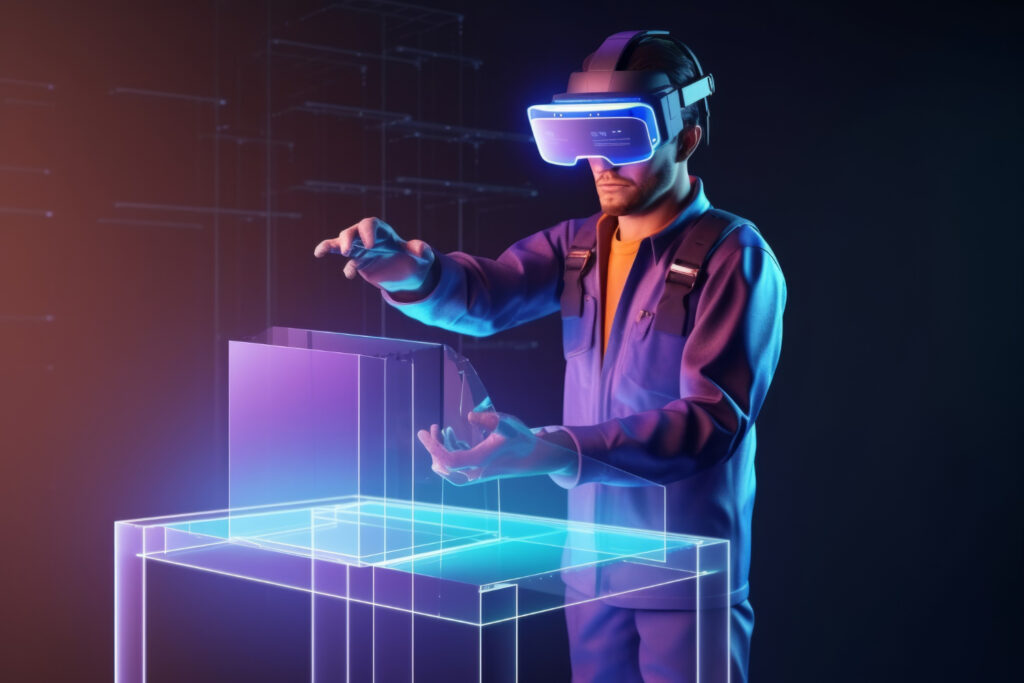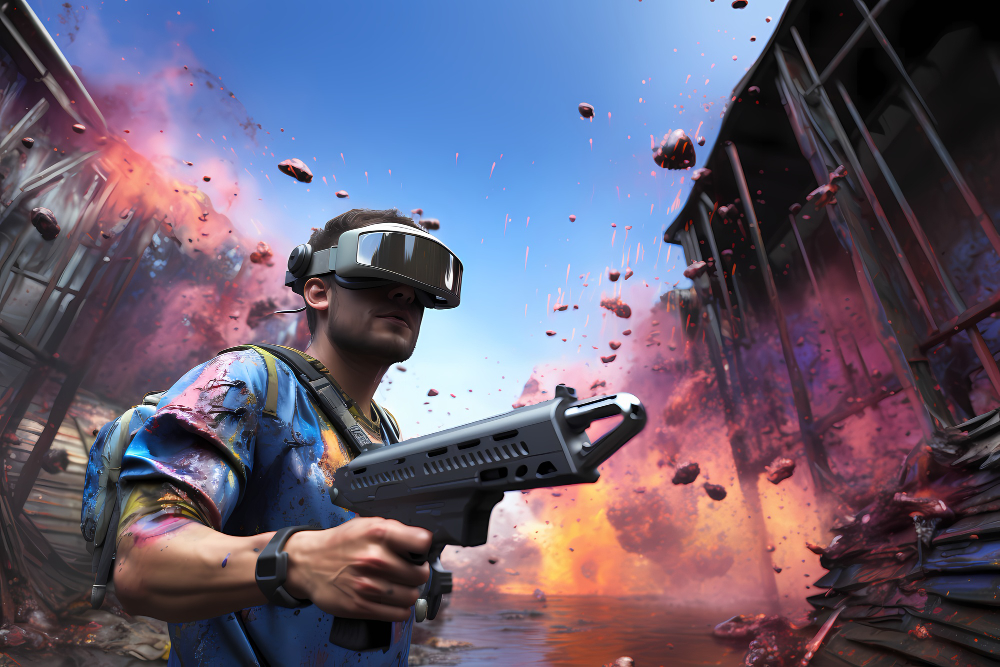Introduction:

The future of augmented reality, or augmented reality, is taking shape; we will learn how in this blog. We are sure you must have crossed paths with our blog on the future of virtual reality But before that, wouldn’t it be great if we could understand what the difference between these two is? Well, let’s begin then.
Virtual reality (VR) and augmented reality (AR)? They both sound pretty cool, right? Well, let me break it down for you in simple terms.
Imagine you’re wearing a special headset that completely transports you to another world. That’s virtual reality (VR). When you put on a VR headset, you’re immersed in a digital environment that feels so real, you might forget you’re still in your living room!

Now, let’s talk about augmented reality (AR). Instead of taking you to a whole new world like VR does, AR adds digital elements to the world around you.
It’s like having a magical pair of glasses that can overlay computer-generated images onto the real world. So, while you’re still in your living room, you might see virtual objects floating in front of you or helpful information displayed on your walls.
Augmented Reality (AR) has emerged as a transformative technology, seamlessly blending the digital world with the physical environment. From its humble beginnings to its widespread adoption across various industries, AR has paved the way for revolutionary advancements. In this blog, we’ll delve into the history of AR, its practical applications, and its promising future across different sectors.

Here’s another way to think about it: VR is like stepping into a completely different universe, while AR is like adding a layer of digital magic to the world you already know.
So, why do we use VR and AR? Well, they both have their own super cool uses! VR is awesome for gaming because it lets you feel like you’re actually inside the game. You can explore new worlds, battle dragons, or even climb Mount Everest—all from the comfort of your own home!
On the other hand, AR is great for blending the digital and real worlds together. Remember those magical glasses I mentioned? They can be used for all sorts of stuff, like trying on clothes without actually wearing them, learning about historical landmarks while you’re visiting them, or even helping doctors visualize complicated surgeries before they even pick up a scalpel.
So, there you have it! Virtual reality takes you to a whole new world, while augmented reality brings a touch of magic to the world you already know. Both are pretty amazing in their own way and who knows what other cool things we’ll be able to do with them in the future!
Future of Augmented Reality

So, let’s talk about the future of augmented reality (AR), because, trust me, it’s going to blow your mind. Picture this: you’re not just watching a movie anymore, you’re IN the movie. That’s the kind of stuff AR is bringing to the table.
So, what’s in store? Well, imagine playing your favorite game, but instead of just staring at a screen, you’re actually dodging obstacles in your living room. Pretty cool, right? And it’s not just about gaming. AR is going to shake things up in education too. Say goodbye to boring textbooks and hello to interactive lessons where you can explore ancient ruins or dissect virtual frogs. Learning’s never been this fun!
But wait, there’s more! Think about shopping. Ever wish you could try on clothes without actually trying them on? AR’s got you covered. With virtual fitting rooms, you can see how that new outfit looks on you without even leaving the house. And hey, who needs a map when you’ve got AR guiding you through the streets, pointing out cool spots along the way?
And let’s not forget about healthcare. Doctors can use AR to perform surgeries with pinpoint accuracy, thanks to virtual overlays showing them exactly where to cut. Patients can even use AR apps to monitor their health and track their progress. It’s like having a personal health assistant right in your pocket!
Social AR Experiences:
Augmented reality is becoming increasingly social, with platforms like Snapchat and Instagram introducing AR filters and lenses that allow users to enhance their photos and videos with digital effects.

This can also be used as a marketing strategy by companies to create more brand awareness among the audience globally. Expect to see more social AR experiences that enable real-time interaction and collaboration among users.
Spatial Computing:
Spatial computing is a key trend in augmented reality that focuses on understanding and interacting with the physical world in real time. With advancements in technologies like depth-sensing cameras and LiDAR, AR devices can accurately perceive and interact with the environment, enabling more realistic and immersive experiences.
AR Cloud:
The AR cloud is a concept that refers to a shared digital layer that overlays the physical world, allowing users to access and interact with persistent augmented reality content.

As the AR cloud continues to develop, we can expect to see more seamless and integrated AR experiences that bridge the gap between the digital and physical worlds.
Wearable AR Devices:

Wearable augmented reality devices, such as smart glasses and headsets, are gaining momentum as the technology becomes more advanced and affordable.
These devices offer hands-free access to AR content, making them ideal for applications like navigation, remote assistance, and gaming. As wearable AR technology continues to evolve, we can anticipate broader adoption and new use cases emerging.
AR Gaming:
AR is being driven largely by the gaming industry, as developers are making better AR devices and adding AR components to classic games. Startups like smar.toys and Mohx-games mix AR gameplay with physical toys and push the development of multiplayer AR games.

Conclusion
Augmented reality’s (AR) future is bright and diverse. The AR market is anticipated to expand rapidly, particularly in North America, a hub for cutting-edge innovation and technology. The increasing use of augmented reality (AR) in a variety of sectors, such as retail, automotive, and healthcare, is driving this expansion.
According to industry estimates, the AR market is expected to proliferate with a compound annual growth rate (CAGR) of 51.6% from 2024 to 2030. Furthermore, it is anticipated that the AR/VR industry will expand at a five-year compound growth rate of 33.2% to reach $60.1 billion by 2026.
These advancements in a range of industries point to augmented reality’s promising future, which will change our daily interactions with technology and our ability to work in a variety of fields.

